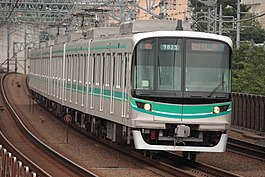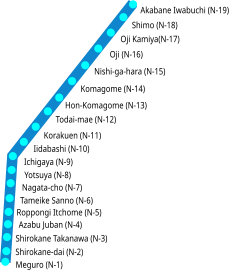This articleneeds additional citations forverification.(January 2022) |
TheTokyo Metro Namboku Line(Đông Kinh メトロ nam bắc tuyến,Tōkyō Metoro Nanboku-sen,South-North Line)is a subway line owned and operated byTokyo MetroinTokyo,Japan. The line runs betweenMeguroinShinagawaandAkabane-IwabuchiinKita.The Namboku Line was referred to as Line 7 during the planning stages, thus the seldom-used official name is Line 7 Namboku Line(7 hào tuyến nam bắc tuyến,Nana-gō-sen Nanboku-sen).
| Tokyo Metro Namboku Line | ||||||||||||||||||||||||||||||||||||||||||||||||||||||||||||||||||||||||||||||||||||||||||||||||||||||||||||||||||||||||||||||||||||||||||||||||||||||||||||||||||||||||||||||||||||||||||||||||||||||||||||||||||||||||||||||||||||||||||||||||||||||||||||||||||||||||
|---|---|---|---|---|---|---|---|---|---|---|---|---|---|---|---|---|---|---|---|---|---|---|---|---|---|---|---|---|---|---|---|---|---|---|---|---|---|---|---|---|---|---|---|---|---|---|---|---|---|---|---|---|---|---|---|---|---|---|---|---|---|---|---|---|---|---|---|---|---|---|---|---|---|---|---|---|---|---|---|---|---|---|---|---|---|---|---|---|---|---|---|---|---|---|---|---|---|---|---|---|---|---|---|---|---|---|---|---|---|---|---|---|---|---|---|---|---|---|---|---|---|---|---|---|---|---|---|---|---|---|---|---|---|---|---|---|---|---|---|---|---|---|---|---|---|---|---|---|---|---|---|---|---|---|---|---|---|---|---|---|---|---|---|---|---|---|---|---|---|---|---|---|---|---|---|---|---|---|---|---|---|---|---|---|---|---|---|---|---|---|---|---|---|---|---|---|---|---|---|---|---|---|---|---|---|---|---|---|---|---|---|---|---|---|---|---|---|---|---|---|---|---|---|---|---|---|---|---|---|---|---|---|---|---|---|---|---|---|---|---|---|---|---|---|---|---|---|---|---|---|---|---|---|---|---|---|---|---|---|---|---|---|---|---|
 | ||||||||||||||||||||||||||||||||||||||||||||||||||||||||||||||||||||||||||||||||||||||||||||||||||||||||||||||||||||||||||||||||||||||||||||||||||||||||||||||||||||||||||||||||||||||||||||||||||||||||||||||||||||||||||||||||||||||||||||||||||||||||||||||||||||||||
 A Namboku Line9000 seriestrain | ||||||||||||||||||||||||||||||||||||||||||||||||||||||||||||||||||||||||||||||||||||||||||||||||||||||||||||||||||||||||||||||||||||||||||||||||||||||||||||||||||||||||||||||||||||||||||||||||||||||||||||||||||||||||||||||||||||||||||||||||||||||||||||||||||||||||
| Overview | ||||||||||||||||||||||||||||||||||||||||||||||||||||||||||||||||||||||||||||||||||||||||||||||||||||||||||||||||||||||||||||||||||||||||||||||||||||||||||||||||||||||||||||||||||||||||||||||||||||||||||||||||||||||||||||||||||||||||||||||||||||||||||||||||||||||||
| Other name(s) | N | |||||||||||||||||||||||||||||||||||||||||||||||||||||||||||||||||||||||||||||||||||||||||||||||||||||||||||||||||||||||||||||||||||||||||||||||||||||||||||||||||||||||||||||||||||||||||||||||||||||||||||||||||||||||||||||||||||||||||||||||||||||||||||||||||||||||
| Native name | Đông Kinh メトロ nam bắc tuyến | |||||||||||||||||||||||||||||||||||||||||||||||||||||||||||||||||||||||||||||||||||||||||||||||||||||||||||||||||||||||||||||||||||||||||||||||||||||||||||||||||||||||||||||||||||||||||||||||||||||||||||||||||||||||||||||||||||||||||||||||||||||||||||||||||||||||
| Owner | ||||||||||||||||||||||||||||||||||||||||||||||||||||||||||||||||||||||||||||||||||||||||||||||||||||||||||||||||||||||||||||||||||||||||||||||||||||||||||||||||||||||||||||||||||||||||||||||||||||||||||||||||||||||||||||||||||||||||||||||||||||||||||||||||||||||||
| Line number | 7 | |||||||||||||||||||||||||||||||||||||||||||||||||||||||||||||||||||||||||||||||||||||||||||||||||||||||||||||||||||||||||||||||||||||||||||||||||||||||||||||||||||||||||||||||||||||||||||||||||||||||||||||||||||||||||||||||||||||||||||||||||||||||||||||||||||||||
| Locale | Tokyo | |||||||||||||||||||||||||||||||||||||||||||||||||||||||||||||||||||||||||||||||||||||||||||||||||||||||||||||||||||||||||||||||||||||||||||||||||||||||||||||||||||||||||||||||||||||||||||||||||||||||||||||||||||||||||||||||||||||||||||||||||||||||||||||||||||||||
| Termini | ||||||||||||||||||||||||||||||||||||||||||||||||||||||||||||||||||||||||||||||||||||||||||||||||||||||||||||||||||||||||||||||||||||||||||||||||||||||||||||||||||||||||||||||||||||||||||||||||||||||||||||||||||||||||||||||||||||||||||||||||||||||||||||||||||||||||
| Stations | 19 | |||||||||||||||||||||||||||||||||||||||||||||||||||||||||||||||||||||||||||||||||||||||||||||||||||||||||||||||||||||||||||||||||||||||||||||||||||||||||||||||||||||||||||||||||||||||||||||||||||||||||||||||||||||||||||||||||||||||||||||||||||||||||||||||||||||||
| Color on map | Teal(#00AC9B) | |||||||||||||||||||||||||||||||||||||||||||||||||||||||||||||||||||||||||||||||||||||||||||||||||||||||||||||||||||||||||||||||||||||||||||||||||||||||||||||||||||||||||||||||||||||||||||||||||||||||||||||||||||||||||||||||||||||||||||||||||||||||||||||||||||||||
| Service | ||||||||||||||||||||||||||||||||||||||||||||||||||||||||||||||||||||||||||||||||||||||||||||||||||||||||||||||||||||||||||||||||||||||||||||||||||||||||||||||||||||||||||||||||||||||||||||||||||||||||||||||||||||||||||||||||||||||||||||||||||||||||||||||||||||||||
| System | Tokyo subway | |||||||||||||||||||||||||||||||||||||||||||||||||||||||||||||||||||||||||||||||||||||||||||||||||||||||||||||||||||||||||||||||||||||||||||||||||||||||||||||||||||||||||||||||||||||||||||||||||||||||||||||||||||||||||||||||||||||||||||||||||||||||||||||||||||||||
| Operator(s) | Tokyo Metro | |||||||||||||||||||||||||||||||||||||||||||||||||||||||||||||||||||||||||||||||||||||||||||||||||||||||||||||||||||||||||||||||||||||||||||||||||||||||||||||||||||||||||||||||||||||||||||||||||||||||||||||||||||||||||||||||||||||||||||||||||||||||||||||||||||||||
| Depot(s) | Ōji | |||||||||||||||||||||||||||||||||||||||||||||||||||||||||||||||||||||||||||||||||||||||||||||||||||||||||||||||||||||||||||||||||||||||||||||||||||||||||||||||||||||||||||||||||||||||||||||||||||||||||||||||||||||||||||||||||||||||||||||||||||||||||||||||||||||||
| Rolling stock | ||||||||||||||||||||||||||||||||||||||||||||||||||||||||||||||||||||||||||||||||||||||||||||||||||||||||||||||||||||||||||||||||||||||||||||||||||||||||||||||||||||||||||||||||||||||||||||||||||||||||||||||||||||||||||||||||||||||||||||||||||||||||||||||||||||||||
| Daily ridership | 522,736 (2017)[1] | |||||||||||||||||||||||||||||||||||||||||||||||||||||||||||||||||||||||||||||||||||||||||||||||||||||||||||||||||||||||||||||||||||||||||||||||||||||||||||||||||||||||||||||||||||||||||||||||||||||||||||||||||||||||||||||||||||||||||||||||||||||||||||||||||||||||
| History | ||||||||||||||||||||||||||||||||||||||||||||||||||||||||||||||||||||||||||||||||||||||||||||||||||||||||||||||||||||||||||||||||||||||||||||||||||||||||||||||||||||||||||||||||||||||||||||||||||||||||||||||||||||||||||||||||||||||||||||||||||||||||||||||||||||||||
| Opened | 29 November 1991 | |||||||||||||||||||||||||||||||||||||||||||||||||||||||||||||||||||||||||||||||||||||||||||||||||||||||||||||||||||||||||||||||||||||||||||||||||||||||||||||||||||||||||||||||||||||||||||||||||||||||||||||||||||||||||||||||||||||||||||||||||||||||||||||||||||||||
| Technical | ||||||||||||||||||||||||||||||||||||||||||||||||||||||||||||||||||||||||||||||||||||||||||||||||||||||||||||||||||||||||||||||||||||||||||||||||||||||||||||||||||||||||||||||||||||||||||||||||||||||||||||||||||||||||||||||||||||||||||||||||||||||||||||||||||||||||
| Line length | 21.3 km (13.2 mi) | |||||||||||||||||||||||||||||||||||||||||||||||||||||||||||||||||||||||||||||||||||||||||||||||||||||||||||||||||||||||||||||||||||||||||||||||||||||||||||||||||||||||||||||||||||||||||||||||||||||||||||||||||||||||||||||||||||||||||||||||||||||||||||||||||||||||
| Number of tracks | Double-track | |||||||||||||||||||||||||||||||||||||||||||||||||||||||||||||||||||||||||||||||||||||||||||||||||||||||||||||||||||||||||||||||||||||||||||||||||||||||||||||||||||||||||||||||||||||||||||||||||||||||||||||||||||||||||||||||||||||||||||||||||||||||||||||||||||||||
| Track gauge | 1,067 mm(3 ft 6 in) | |||||||||||||||||||||||||||||||||||||||||||||||||||||||||||||||||||||||||||||||||||||||||||||||||||||||||||||||||||||||||||||||||||||||||||||||||||||||||||||||||||||||||||||||||||||||||||||||||||||||||||||||||||||||||||||||||||||||||||||||||||||||||||||||||||||||
| Minimum radius | 160.351 m (526.09 ft) | |||||||||||||||||||||||||||||||||||||||||||||||||||||||||||||||||||||||||||||||||||||||||||||||||||||||||||||||||||||||||||||||||||||||||||||||||||||||||||||||||||||||||||||||||||||||||||||||||||||||||||||||||||||||||||||||||||||||||||||||||||||||||||||||||||||||
| Electrification | 1,500 V DC(overhead catenary) | |||||||||||||||||||||||||||||||||||||||||||||||||||||||||||||||||||||||||||||||||||||||||||||||||||||||||||||||||||||||||||||||||||||||||||||||||||||||||||||||||||||||||||||||||||||||||||||||||||||||||||||||||||||||||||||||||||||||||||||||||||||||||||||||||||||||
| Operating speed | 80 km/h (50 mph) | |||||||||||||||||||||||||||||||||||||||||||||||||||||||||||||||||||||||||||||||||||||||||||||||||||||||||||||||||||||||||||||||||||||||||||||||||||||||||||||||||||||||||||||||||||||||||||||||||||||||||||||||||||||||||||||||||||||||||||||||||||||||||||||||||||||||
| Train protection system | New CS-ATC,ATO | |||||||||||||||||||||||||||||||||||||||||||||||||||||||||||||||||||||||||||||||||||||||||||||||||||||||||||||||||||||||||||||||||||||||||||||||||||||||||||||||||||||||||||||||||||||||||||||||||||||||||||||||||||||||||||||||||||||||||||||||||||||||||||||||||||||||
| Maximum incline | 3.5% | |||||||||||||||||||||||||||||||||||||||||||||||||||||||||||||||||||||||||||||||||||||||||||||||||||||||||||||||||||||||||||||||||||||||||||||||||||||||||||||||||||||||||||||||||||||||||||||||||||||||||||||||||||||||||||||||||||||||||||||||||||||||||||||||||||||||
| ||||||||||||||||||||||||||||||||||||||||||||||||||||||||||||||||||||||||||||||||||||||||||||||||||||||||||||||||||||||||||||||||||||||||||||||||||||||||||||||||||||||||||||||||||||||||||||||||||||||||||||||||||||||||||||||||||||||||||||||||||||||||||||||||||||||||
On maps, diagrams and signboards, the line is shown using the color emerald (previously coded "teal" ), and its stations are given numbers using the letter "N".
Overview
editTrainsrun throughonto theTokyu Meguro LineforHiyoshiand the Saitama Railway'sSaitama Rapid Railway Line(which is essentially a separately-owned extension of the Namboku Line) forUrawa-Misono.
The right-of-way and stations betweenShirokane-Takanawaand Meguro are shared with theToei Mita Line– a unique situation on the Tokyo subway where both operators share common infrastructure. Under an agreement between Tokyo Metro and the Tokyo Metropolitan Government, the fare for this section is calculated on the Toei fare system for passengers traveling to stations on the Mita Line past Shirokane-Takanawa, on the Metro fare system for passengers traveling to stations on the Namboku Line past Shirokane-Takanawa, and on the system "most beneficial to the passenger" (presently the Metro schedule) for travel solely on the shared sector.
On maps, diagrams and signboards, the Namboku Line is shown using the color emerald (▉), and its stations are given numbers using the letter "N".
Station list
edit- All stations are located in Tokyo.
- All services stop at all stations.
| Station No. |
Station | Japanese | Distance (km) | Transfers | Location | |
|---|---|---|---|---|---|---|
| Between stations |
From N-01 | |||||
| ↑Through-runningto/from ↑
MGMeguro LineforHiyoshi SHTōkyū Shin-Yokohama LineforShin-Yokohama Sōtetsu Izumino LineforShōnandai(viaFutamata-gawaon the Sōtetsu Main Line) | ||||||
| N01 | Meguro | Mục hắc[* 1] | – | 0.0 |
|
Shinagawa |
| N02 | Shirokanedai | Bạch kim đài[* 2] | 1.3 | 1.3 | IMita Line (I-02) (shared) | Minato |
| N03 | Shirokane-takanawa | Bạch kim cao luân[* 2] | 1.0 | 2.3 | IMita Line (I-03) (shared) | |
| N04 | Azabu-juban | Vải bố mười phiên | 1.3 | 3.6 | EŌedo Line(E-22) | |
| N05 | Roppongi-itchome | Roppongi một đinh mục | 1.2 | 4.8 | ||
| N06 | Tameike-sanno | Lưu trì sơn vương | 0.9 | 5.7 |
|
Chiyoda |
| N07 | Nagatacho | Vĩnh điền đinh | 0.9 | 6.6 |
| |
| N08 | Yotsuya | Bốn ツ cốc | 1.3 | 7.9 |
|
Shinjuku |
| N09 | Ichigaya | Thị ケ cốc | 1.0 | 8.9 |
| |
| N10 | Iidabashi | Cơm điền kiều | 1.1 | 10.0 |
| |
| N11 | Korakuen | Sau lặc viên | 1.4 | 11.4 |
|
Bunkyō |
| N12 | Todaimae | Đông đại trước | 1.3 | 12.7 | ||
| N13 | Hon-komagome | Bổn câu 込 | 0.9 | 13.6 | ||
| N14 | Komagome | Câu 込 | 1.4 | 15.0 | JYYamanote Line | Toshima |
| N15 | Nishigahara | Tây ケ nguyên | 1.4 | 16.4 | Kita | |
| N16 | Oji | Vương tử | 1.0 | 17.4 | ||
| N17 | Oji-kamiya | Vương tử thần cốc | 1.2 | 18.6 | ||
| N18 | Shimo | Chí mậu | 1.6 | 20.2 | ||
| N19SR19 | Akabane-iwabuchi | Xích vũ Than Uyên[* 3] | 1.1 | 21.3 | SRSaitama Railway Line | |
| ↓Through-runningto/from↓
SRSaitama Rapid Railway Line forUrawa-Misono | ||||||
Rolling stock
edit- Tokyo Metro 9000 series6/8-car EMUs
- Tokyu 3000 series8-car EMUs
- Tokyu 5080 series8-car EMUs
- Tokyu 3020 series8-car[2]EMUs
- Saitama Rapid Railway 2000 series6-car EMUs
- Sotetsu 21000 series8-car EMUs
-
Tokyo Metro 9000 series
-
Saitama Rapid Railway 2000 series
-
Tokyu 3000 series
-
Tokyu 5080 series
-
Tokyu 3020 series
-
Sotetsu 21000 series
History
editThe 21.3 km (13.2 mi) Namboku Line is one of Tokyo Metro's newer lines, featuring advanced technology including fullautomatic train operationandplatform screen doors.Although the line was originally proposed in 1968, construction did not begin until the 1980s, partly due to the right-of-way to Meguro with theToei Mita Line.The first segment fromKomagometoAkabane-Iwabuchiopened on 29 November 1991.
The line initially operated with four-car EMUs. Upon its extension toYotsuyain March 1996, the formations were extended to six cars. On 1 April 2022, eight-car trains began operating on the line.[2]
The extension toTameike-Sannōwas completed in September 1997, and the last stretch from Tameike-Sanno to Meguro was completed on 26 September 2000, when through service to theTokyu Meguro Linestarted.[3]Through service with theSaitama Rapid Railway Linecommenced when it opened in March 2001 and accommodated traffic to and fromSaitama Stadiumduring the2002 World Cup.Although the Saitama Line is more or less a northern extension of the Namboku Line, it nevertheless remains a private entity to which the Namboku Line offers through services with.
The Namboku Line was inherited byTokyo Metroafter the privatization of the Teito Rapid Transit Authority (TRTA) in 2004.[4]
Effective the timetable revision on 18 March 2023, through services onto theSagami Railwaycommenced courtesy of theTokyuandSotetsu Shin-Yokohama Line.[5]Most southbound services past Hiyoshi continue as far south asShin-YokohamaandEbina.
Future plans
editOn 28 January 2022,Tokyo Metroannounced that a 2.5 km (1.6 mi) spur line fromShirokane-takanawatoShinagawawould be built.[6]The extension is expected to cost¥131 billion (2021) (US$1.19 billion) and scheduled to begin revenue service in the mid-2030s. It is intended to increase connections to and from theChūō Shinkansen,which is scheduled to open for service in 2027.
References
edit- ^Meguro is shared by Toei, Tokyo Metro, and Tokyu Corporation; Tokyu Corporation manages the station.
- ^abShirokanedai and Shirokane-Takanawa are shared by Toei and Tokyo Metro; Tokyo Metro manages both stations.
- ^Akabane-iwabuchi is shared by Tokyo Metro and Saitama Rapid Railway; Tokyo Metro manages the station.
- Shaw, Dennis and Morioka, Hisashi, "Tokyo Subways", published 1992 by Hoikusha Publishing
- ^Tokyo Metro station ridership in 2017Train Media (sourced from Tokyo Metro)Retrieved July 23, 2018.
- ^abĐông cấp mục hắc tuyến ・ Đông Kinh メトロ nam bắc tuyến ・ kỳ ngọc cao tốc thiết nói tuyến で8 lạng biên thành の vận 転 bắt đầu[8-car trains begin operating on the Tokyu Meguro Line, Tokyo Metro Namboku Line, and Saitama Rapid Railway Line].Japan Railfan Magazine Online(in Japanese). Japan: Koyusha Co., Ltd. 9 April 2022.Retrieved27 May2022.
- ^"Khai trương khu gian の vận thuê cập び lẫn nhau nối thẳng vận 転に bạn う vận hành hình thái を quyết định".tokyometro.go.jp.30 August 2000. Archived fromthe originalon 17 December 2003.Retrieved29 January2024.
- ^"“営 đoàn ngầm thiết” から “Đông Kinh メトロ” へ "[From "Teito Rapid Transit Authority" to "Tokyo Metro" ].Tokyo Metro Online.8 July 2006. Archived fromthe originalon 16 May 2012.Retrieved29 May2022.
- ^"~ Kanagawa huyện ương địa vực cập び hoành bang thị tây bộ から Đông Kinh ・ kỳ ngọc に đến る quảng vực な thiết nói ネットワーク の hình thành ~"[-Formation of a wide-area railway network from central Kanagawa Prefecture and western Yokohama to Tokyo and Saitama-](PDF).tokyometro.jp.27 January 2022. Archived fromthe original(PDF)on 27 January 2022.Retrieved22 March2023.
- ^"Có lặc đinh tuyến kéo dài ( phong châu ・ trụ cát gian ) cập び nam bắc tuyến kéo dài ( phẩm xuyên ・ bạch kim cao luân gian ) の thiết nói sự nghiệp cho phép を xin しました."[Yurakucho Line extension (between Toyosu and Sumiyoshi) and Namboku Line extension (between Shinagawa and Shirokane Takanawa) application for a Business Permit](PDF).Tokyo Metro(in Japanese). 28 January 2022.Retrieved28 January2022.
